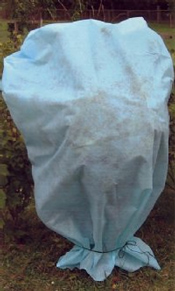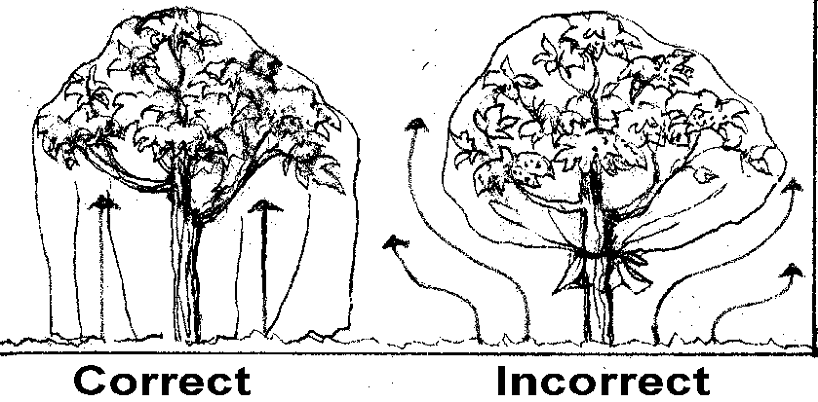What a difference a year makes. This time last year our growing degree day accumulations were nearly a month ahead of normal and we had already experienced temperatures in the 80’s, with more than a week straight of 70 + deg. temperatures. This year, of course, is a different story. But spring will come eventually. As trees and shrubs begin to leaf out or we get antsy and begin to plant annuals, we need to be prepared for late frosts.
Searching on the internet for ‘plant frost protection’ will yield a wide array of strategies for reducing frost damage. Some strategies such as frost irrigation or wind turbines are mainly geared to commercial horticultural operations such as orchards or nurseries. Other techniques such as a various spray-on products usually provide only a few degrees of protection or are variable in their effectiveness. For homeowners, the most effective technique is the ‘old tried and true’; covering plants loosely with a bed sheet or similar lightweight fabric.

Photo: gardeingadvice.net
When covering plants for frost protection it is important to remember the basic principle at work here. Late frosts typically occur on clear nights. That’s because the lack of cloud cover allows heat from the earth to re-radiate into outer space. By draping a sheet or other lightweight covering over plants, the radiant heat from the ground is trapped, preventing plants from freezing.

I bring this up because I have seen several forms of ‘plant protection bags’ currently on the market. In terms of protection from late frosts, these are more likely to turn out to be plant body bags. Some of these bags are designed to gather at the base; sort of like putting on a coat. This is another example where making analogies between human function and plant function falls apart.

Remember, the point of covering plants is to trap the earth’s heat, not the plant’s heat.

More importantly, frost cover protection needs to be removed each morning as soon as temperatures begin to warm. Late frosts usually occur on clear nights, which means the next morning is typically bright and sunny. Under direct sun, temperatures under frost covers can build quickly, resulting in heat damage to new growth. Yes, going out to drape sheets over plants each evening and then removing them the next morning is a pain but like so many things in life, the tried and true is the safest bet.
Excellent article that resonates with me as my business is the home orchard and nursery co.
I usually don’t have old sheets around as they are quickly put to use as rags but I accomplish the same success with plastic tarps honoring the principle of trapping heat on its way up. Of course leaves trapped against the tarp freeze but constructing a frame is time consuming.
I love this blog! I do this in my garden with old ratty pieces of row cover fabric. Between that and openin
g and closing tunnel cloches daily, it’s just part of the routine of waking the garden in the morning and putting it to bed at night!
I was told to not let the cover touch the foliage as it conducts the cold to the leaf. (?)
Robert:
Depends on what you’re covering and what’s practical. Ideally the cover should not come into contact with the foliage – as Alan notes you can get some frosted leaves. For garden plants and raised beds it may be possible to use stakes or rig up a frame to place the cover over – for trees and shrubs draping usually works fine. Also you can reduce some heat conduction by using fabric rather than plastic.
If you don’t have anything else to use you can make a frame for vegetables by taping straight branches together with electric tape or just sticking non-pointy pieces of wood in the ground above the vegies to provide some distance of cover from leaves.